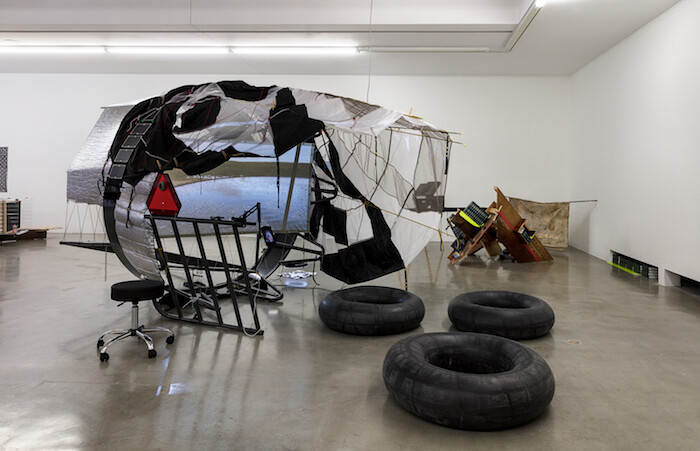Categories
Subjects
Authors
Artists
Venues
Locations
Calendar
Filter
Done
June 23, 2022 – Review
American Artist’s “Shaper of God”
Jonathan Griffin

About 15 minutes’ drive from the mirrored towers of downtown Los Angeles, a shady canyon throngs with oaks, willows, sycamores, and cottonwoods. Treefrog tadpoles wriggle in the creek. Snakes hunt among the rocks. Visitors to Hahamongna Watershed Park, named after the Tongvan village that once existed there, also cannot miss the adjacent white buildings of the Jet Propulsion Laboratory, a giant research facility owned by NASA.
This discordant landscape, according to a text accompanying American Artist’s exhibition “Shaper of God,” was an inspiration to the science fiction author Octavia E. Butler, who set several of her novels in nearby Altadena and Pasadena, where she lived for much of her life. (Butler died in 2006, at 58.) The exhibition, dominated by recreations of urban street furniture, is really a single installation made from several semi-autonomous artworks. Its enigmatic title derives from a verse in the fictional religious text The Books of the Living, quoted in Butler’s nightmarish futurist novel Parable of the Sower (1993): “We do not worship God. / We perceive and attend God. / We learn from God. / With forethought and work, / We shape God.”
Among other themes, Parable of the Sower is about self-determination in the …
April 16, 2018 – Review
Dave Hullfish Bailey’s “Hardscrabble”
Travis Diehl

Like a thesis hidden in a footnote, a small projection in one corner of an exhibition of junkyard complexity shows a loop from John Ford’s The Man Who Shot Liberty Valance (1962), starring John Wayne and James Stewart. In the scene, Stewart’s character, a lawyer in the frontier town of Shinbone, sits before a schoolroom full of kids and adults. He’s learnin’ them readin’ and writin’, where no one else will. He is also, lawyerly, teaching them about the law of the land, paraphrased thus: “The people… are… the boss!” It is a lesson in the John Ford mold—as self-evident and patronizing as Stewart’s words of praise: “That’s fine. That’s just fine.” The same goes for the film’s plot, which pits the outlaw and rustler Valance against the fence- and property-line-loving townsfolk, who just want to raise their sheep in peace. The film is a latter-day Ford allegory: “liberty,” an old idea, must be gunned down, now that we’ve outgrown untrammeled, unfenced ranges and need regimented “lots,” “towns,” and “ranches” instead. REDCAT being an exhibition space and not a grade school, the viewer is encouraged to be skeptical about the purity of such motivations as the anti-entropic philosophy of manifest …